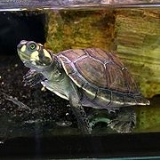
Yellow-spotted river turtle
Encyclopedia
The Yellow-spotted river turtle (also known as the Yellow-spotted Amazon river turtle) is one of the largest South American river turtles. It can grow up to 45 cm long and weigh up to 8 kg
. This species can be recognized by its black or brown oval carapace
(upper shell) with distinctive low keels on the second and third scute
s. Yellow spots on the side of its head give this species its common name. These spots are most prominent in juveniles and fade with age. Females can be up to twice the size of males. Note that the photo is of a juvenile.
Podocnemis unifilis (the scientific name for this species) is a type of side-necked turtle, so called because they do not pull their heads directly into their shell, but rather bend the neck sideways to tuck the head under the rim of the shell. Side-neck turtles are classified as members of the suborder Pleurodira.
There are several other species within the genus.
These turtles are found in tributaries and large lakes of South America's Amazon Basin
. During flood season, they may venture into flooded forests or floodplain lakes. They feed on fruits, weeds, fish, and small invertebrate
s.
The females lay two clutches of eggs each year, each with 4 to 35 eggs in it. They make their nests in sandy areas on the banks of rivers where the eggs will hatch 66 to 159 days after they are laid. The eggs are laid at the peak of dry season so that the nest will not be washed away with the floods of the rainy season.
the average life span of the Yellow-Spotted Amazon River Turtle is 60 to 70 years.
Podocnemis unifilis was one of the foreign species exploited by the American pet turtle trade in the 1960s. Importation of this species is now strictly regulated by Federal law but a CSSP (Captive Self-Sustaining Population) exists in the United States—some groups in zoos, others in the hands of private collectors. Individuals of this species have lived more than 30 years in captivity.
Kilogram
The kilogram or kilogramme , also known as the kilo, is the base unit of mass in the International System of Units and is defined as being equal to the mass of the International Prototype Kilogram , which is almost exactly equal to the mass of one liter of water...
. This species can be recognized by its black or brown oval carapace
Carapace
A carapace is a dorsal section of the exoskeleton or shell in a number of animal groups, including arthropods such as crustaceans and arachnids, as well as vertebrates such as turtles and tortoises. In turtles and tortoises, the underside is called the plastron.-Crustaceans:In crustaceans, the...
(upper shell) with distinctive low keels on the second and third scute
Scute
A scute or scutum is a bony external plate or scale, as on the shell of a turtle, the skin of crocodilians, the feet of some birds or the anterior portion of the mesonotum in insects.-Properties:...
s. Yellow spots on the side of its head give this species its common name. These spots are most prominent in juveniles and fade with age. Females can be up to twice the size of males. Note that the photo is of a juvenile.
Podocnemis unifilis (the scientific name for this species) is a type of side-necked turtle, so called because they do not pull their heads directly into their shell, but rather bend the neck sideways to tuck the head under the rim of the shell. Side-neck turtles are classified as members of the suborder Pleurodira.
There are several other species within the genus.
These turtles are found in tributaries and large lakes of South America's Amazon Basin
Amazon Basin
The Amazon Basin is the part of South America drained by the Amazon River and its tributaries that drains an area of about , or roughly 40 percent of South America. The basin is located in the countries of Bolivia, Brazil, Colombia, Ecuador, Guyana, Peru, and Venezuela...
. During flood season, they may venture into flooded forests or floodplain lakes. They feed on fruits, weeds, fish, and small invertebrate
Invertebrate
An invertebrate is an animal without a backbone. The group includes 97% of all animal species – all animals except those in the chordate subphylum Vertebrata .Invertebrates form a paraphyletic group...
s.
The females lay two clutches of eggs each year, each with 4 to 35 eggs in it. They make their nests in sandy areas on the banks of rivers where the eggs will hatch 66 to 159 days after they are laid. The eggs are laid at the peak of dry season so that the nest will not be washed away with the floods of the rainy season.
the average life span of the Yellow-Spotted Amazon River Turtle is 60 to 70 years.
Podocnemis unifilis was one of the foreign species exploited by the American pet turtle trade in the 1960s. Importation of this species is now strictly regulated by Federal law but a CSSP (Captive Self-Sustaining Population) exists in the United States—some groups in zoos, others in the hands of private collectors. Individuals of this species have lived more than 30 years in captivity.

